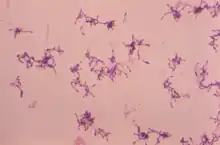Rothia (bacterium)
Rothia is a Gram-positive, aerobic, rod-shaped and non-motile bacterial genus from the family Micrococcaceae.[1][2][3] Rothia bacteria can cause disease in humans and immunosuppressed humans.[4][5]
| Rothia | |
|---|---|
 | |
| Rothia dentocariosa, Gram stain. | |
| Scientific classification | |
| Domain: | Bacteria |
| Phylum: | Actinomycetota |
| Class: | Actinomycetia |
| Order: | Micrococcales |
| Family: | Micrococcaceae |
| Genus: | Rothia Georg and Brown 1967 (Approved Lists 1980) |
| Type species | |
| Rothia dentocariosa corrig. (Onishi 1949) Georg and Brown 1967 (Approved Lists 1980) | |
| Species[1] | |
| |
| Synonyms[1] | |
| |
Rothia is prevalent in human saliva and it produces enterobactin. Rothia is also prevalent in the human gut and can cause the emergence of gastric atrophy and intestinal metaplasia.[6][7]
References
- Parte, A.C. "Rothia". LPSN.
- David E., Swayne; John R., Glisson; Larry R., McDougald; Lisa K., Nolan; David L., Suarez; Venugopal L., Nair (2013). Diseases of Poultry. John Wiley & Sons. ISBN 978-1-118-71973-2.
- Austin, Brian (1 January 2015). "Rothia". Bergey's Manual of Systematics of Archaea and Bacteria. John Wiley & Sons, Ltd: 1–13. doi:10.1002/9781118960608.gbm00124. ISBN 9781118960608.
- Schlossberg, David, ed. (2015). Clinical infectious disease (Second ed.). Cambridge, United Kingdom: Cambridge University Press. ISBN 9781107038912.
- (Hrsg.), Gholamreza Darai; et al. (2012). Lexikon der Infektionskrankheiten des Menschen Erreger, Symptome, Diagnose, Therapie und Prophylaxe (4., vollständig überarbeitete und aktualisierte Aufl. ed.). Berlin: Springer. ISBN 978-3-642-17158-1.
- Uranga, Carla; Arroyo, Pablo; Duggan, Brendan M.; Gerwick, William H.; Edlund, Anna (2020-02-20). "Commensal oral Rothia mucilaginosa produces enterobactin—a metal chelating siderophore". dx.doi.org. doi:10.1101/2020.02.20.956391. S2CID 213599051. Retrieved 2020-10-13.
- Sung, Joseph J Y; Coker, Olabisi Oluwabukola; Chu, Eagle; Szeto, Chun Ho; Luk, Simson Tsz Yat; Lau, Harry Cheuk Hay; Yu, Jun (2020-01-23). "Gastric microbes associated with gastric inflammation, atrophy and intestinal metaplasia 1 year after Helicobacter pylori eradication". Gut. 69 (9): 1572–1580. doi:10.1136/gutjnl-2019-319826. ISSN 0017-5749. PMC 7456733. PMID 31974133.
Further reading
- Ramanan, Poornima; Barreto, Jason N.; Osmon, Douglas R.; Tosh, Pritish K.; Diekema, D. J. (September 2014). "Rothia Bacteremia: a 10-Year Experience at Mayo Clinic, Rochester, Minnesota". Journal of Clinical Microbiology. 52 (9): 3184–3189. doi:10.1128/JCM.01270-14. PMC 4313135. PMID 24951810.
- George M., Garrity (2012). Bergey's manual of systematic bacteriology (2nd ed.). New York: Springer Science + Business Media. ISBN 978-0-387-68233-4.
This article is issued from Wikipedia. The text is licensed under Creative Commons - Attribution - Sharealike. Additional terms may apply for the media files.